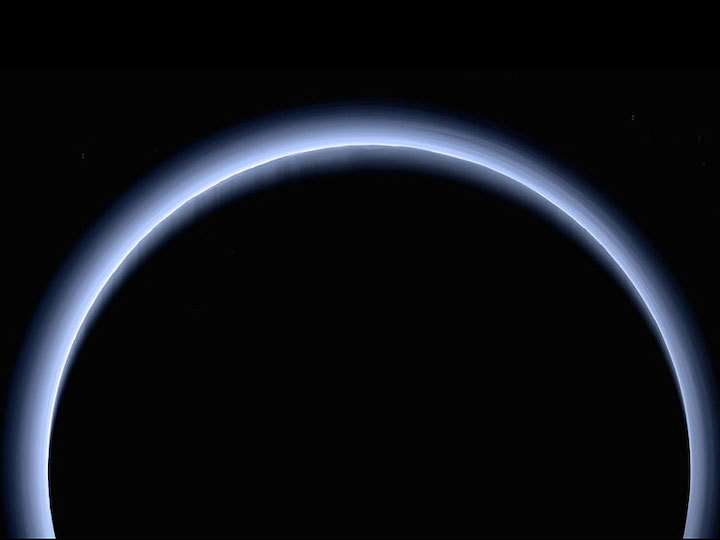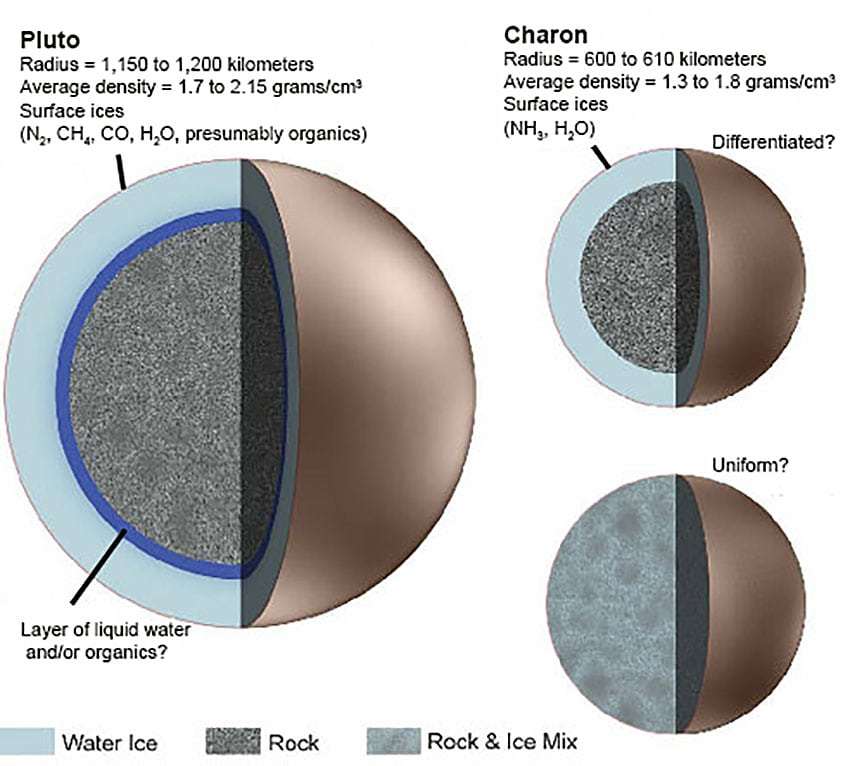24.04.2020
New studies shed light on the early years of Pluto’s formation, and whether it ever hosted a subsurface ocean.

New interpretations of our brief glimpse of Pluto has implications both for its formation and for the early history of the solar system.
Two recent studies looked at the possibility that ancient Pluto may have hosted an ocean underneath its surface. The presentations appeared at the 51st Lunar and Planetary Science Conference in March, which became a virtual meeting due to the ongoing COVID-19 pandemic. While the idea of a subsurface ocean predates the 2015 flyby, these analyses of New Horizons data are providing new evidence in favor of the idea.
HOT START VS. COLD START
One study, titled "The Plausibility of an Ocean on Pluto Shortly After Accretion," used New Horizons' images of Pluto to look at a key question in planetary formation: Did Pluto get off to a cold start, slowly aggregating rock and ice particles? Or did it form more quickly in a hot start, accumulating more heat than it was losing into space? Either scenario has key implications for whether Pluto was capable of hosting an early ocean under an icy surface.
If Pluto formed in a cold start scenario, researchers would expect to see evidence for compression features on Pluto's surface; extensional features would point to a hot start scenario. Either scenario could support a subsurface ocean, but in different ways.
“An early [subsurface] ocean that is refreezing predicts early global extension,” explains lead author Carver Bierson (University of Santa Cruz). “In contrast, an early ice shell melting to form an ocean would produce compressional features.”
Scouring the images returned from New Horizons, the researchers found tentative evidence of extensional features, specifically graben located west of the heart-shape Sputnik Planitia region. These features, which are 4 billion years old according to crater counts in the area, are just what you’d expect to see if the hot start model was correct. To date, no related compression features have been found on Pluto’s surface.

NASA / JHU-APL / SWRI / Alex Parker; Annotations: Carver Bierson
Models of early formation predict that Pluto would see a period of warming via gravitational compression and radioactive decay in the core, followed by widespread extension as ice refroze and swelled.
But the hot start model would have Pluto form in a very short period of time, less than 30,000 years. “If Pluto formed fast, the heat from the impacts adding material can warm Pluto faster than the energy can be radiated to space,” says Bierson. “Other groups trying to explain why so many Kuiper Belt objects (KBOs) have moons suggest that KBOs must form fast. It is great to have these two very independent approaches pointing towards the same answer.”

New Horizons / JHU / APL
“There’s little evidence for compression and very much so for extension,” says William McKinnon (Washington University-St Louis). “Ocean evidence at this point is circumstantial . . . but it is the simplest explanation that makes the most sense.”
Indeed, McKinnon explains, the formation environment may have favored a hot start: “It’s actually really hard to argue for a cold start,” he says, “as there are too many energy sources (from initial formation, radioactive element decay, and the Charon-forming impact) around.”
Though several lines of evidence point to a subsurface ocean on Pluto, they aren’t as definitive as the plume venting the Cassini spacecraft saw at Saturn’s moon Enceladus, say, or the magnetic induction evidence the Galileo spacecraft detected at Jupiter’s moon Europa.
If the hot start theory for Pluto is correct, we should see similar extensional features on Eris, Haumea, and other Kuiper Belt objects, should we ever decide to visit them.
MODELING PLUTO'S INTERIOR
A second study presented at the virtual LPSC conference reported on ripples seen on Pluto's Charon-facing side. These features are consistent with shock waves from the massive impact that is presumed to have formed Sputnik Planitia on the opposite hemisphere.
New Horizons only saw Pluto's Charon-facing hemisphere in low resolution during its 2015 flyby. Nevertheless, the team has run simulations showing that a 400-kilometer (250-mile) diameter impactor striking Pluto at about 2 km/s (5 mph), along with an ancient subsurface ocean 150 kilometers deep, would help explain the surface features we see today.
When a large body smashes into a world, the impact releases seismic waves that travel through to the exact opposite side, explains the study's lead author Adeene Denton (Purdue University). The internal structure of the world thus determines how much damage the seismic waves do in the region on the opposite side as the impact, she adds.
The analysis of features seen on Pluto and the impact simulations in the study allow us to peer inside Pluto and place constraints on its structure and the possible presence and nature of a subsurface ocean.
"We know that deformation at the antipode to Sputnik Planitia is highly responsive to Pluto's ocean thickness and core composition," Denton says. "So, we can examine how oceans of different thicknesses affect deformation at the antipode to determine whether an ocean is necessary for these features to form, and if so, how thick it needs to be."
This preliminary work is promising, she and colleagues write, and suggests that such calculations will provide insight into Pluto's interior structure.

APL / JHU / New Horizons
FUTURE VIEWS
Will we ever go back to Pluto? We only saw one of its hemispheres in high resolution during the 2015 pass. A return would be intriguing, but it would take some time: New Horizons traveled for nearly a decade before flying by Pluto. Even now, researchers are scouring the flight path of New Horizons for a possible 3rd flyby target. (The mission is also conducting a unique parallax experiment — follow the link to see how you can join!)
If we can't go back to Pluto, another intriguing world to explore (and compare to Pluto) would be Neptune’s large moon, Triton, thought to be a captured Kuiper Belt object. Though it’s a ways off, there are proposals to launch an Ice Giant Orbiter mission or set of missions in the 2030s.
For now, we can ponder the brief snapshot that New Horizons provided of Pluto, and wonder what lies within the distant world.
Quelle: Sky&Telescope
